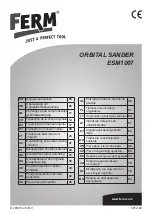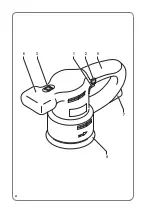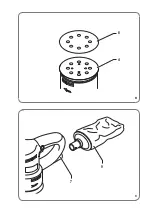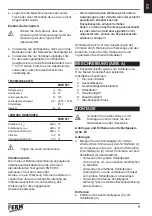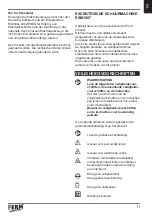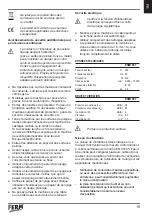
6
EN
Mains plug replacement (UK only)
If the moulded 3-pin plug attached to the unit is
damaged and needs replacing, it is important that
it is correctly destroyed and replaced by an
approved BS 1363/3A fused plug and that the
following wiring instructions are followed.
The wires in the mains cable are coloured in
accordance with the following code:
blue
neutral
brown live
As the colours of the wires in the mains cable
of the unit may not correspond to the coloured
markings identifying the terminals in the plug,
proceed as follows:
- The wire which is coloured blue must be
connected to the terminal which is marked with
the letter N or coloured black.
- The wire which is coloured brown must be
connected to the terminal which is marked with
the letter L or coloured red.
TECHNICAL DATA
ESM1007
Mains voltage
V~ 230
Mains frequency
Hz 50
Power input
W 450
No-load speed
min
-1
9,000 - 13,000
Protection class
IP 20
Weight
kg 2.3
NOISE AND VIBRATION
ESM1007
Sound pressure (L
pa
)
dB(A) 76
Acoustic power (L
wa
)
dB(A) 87
Uncertainty (K)
dB(A) 3
Vibration
m/s
2
5.5
Uncertainty (K)
m/s
2
1.5
2
Wear hearing protection.
Vibration level
The vibration emission level stated in this instruction
manual has been measured in accordance with a
standardised test given in EN 60745; it may be used
to compare one tool with another and as a
preliminary assessment of exposure to vibration
when using the tool for the applications mentioned
- using the tool for different applications, or with
different or poorly maintainted accessories,
may significantly increase the exposure level
- the times when the tool is switched off or when
it is running but not actually doing the job, may
significantly reduce the exposure level
Protect yourself against the effects of vibration by
maintaining the tool and its accessories, keeping
your hands warm, and organizing your work
patterns
DESCRIPTION (fIg. A)
Your orbital sander has been designed for sanding
wood, metal, plastics and painted surfaces.
1. On/off switch
2. Lock-on button
3. Speed adjustment wheel
4. Sanding pad
5. Main grip
6. Auxiliary grip
7. Dustbag connection
ASSEMBLy
4
Before assembly, always switch off the
machine and remove the mains plug
from the mains.
Mounting and removing the sanding paper
(fig. B)
Mounting
● Mount sanding paper (8) with the required
grain size onto the sanding pad (4). Make sure
that the perforation in the sanding paper (8)
corresponds with the perforation on the
sanding pad (4).
- Use coarse sanding paper (grain 50) for
sanding rough, uneven surfaces.
- Use medium sanding paper (grain 80) for
removing the remaining scratches from the
coarse sanding paper.
- Use fine sanding paper (grain 120) for
finishing surfaces.
Removing
● Remove the sanding paper (8) from the
sanding pad (4).
Summary of Contents for ESM1007
Page 2: ...4 7 3 2 5 1 6 A...
Page 3: ...7 9 4 8 C B...
Page 4: ...4 10 D...
Page 74: ...74 RU 2 EN 60745 A 1 2 3 4 5 6 7 4 8 4 8 4 50 80 120 8 4 A 1 1 2 1 1 6 2 3...
Page 75: ...75 RU 9 7 9 4 8 8 D 10 4 4 4 10 4 8 2002 96...
Page 76: ...76 UA ESM1007 Ferm Ferm 1 1 2 3 4 5 A 7 8 9 2...
Page 78: ...78 UA 120 8 4 1 1 2 1 1 6 2 3 C 9 7 9 4 8 8 D 10 4 4 4 10 4...
Page 79: ...79 EL 8 2002 96 EC ESM1007 Ferm Ferm 1 1 2 3 4 5 A...
Page 82: ...82 EL 4 8 8 D 10 4 4 4 10 4 8 2002 96 E...
Page 83: ...83 BG ESM1007 Ferm Ferm 1 1 2 3 4 5 A 7 8 9 2...
Page 85: ...85 BG 8 4 A 1 1 2 1 1 6 2 3 9 7 9 4 B 8 8 D 10 4 4 4 10 4...
Page 86: ...86 BG 8 2002 96 E...
Page 88: ...88...
Page 89: ...89...
Page 90: ...90...
Page 92: ...2009 Ferm B V...

